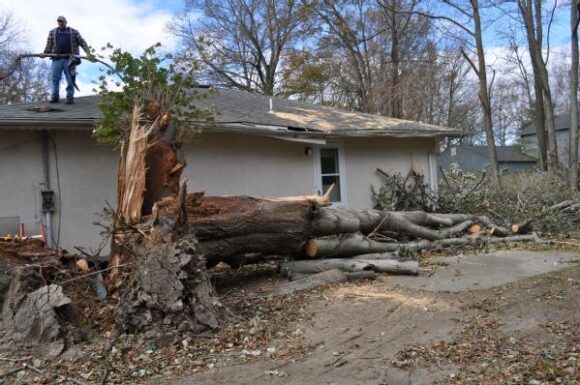First they needed blankets and generators. But before long, many of Superstorm Sandy’s bedraggled survivors also needed a lawyer.
Thousands of people with damaged homes and businesses have sought help with legal headaches ranging from fights with building contractors to insurance disputes.
In the first days after the Oct. 29 storm, mobile legal clinics sprang up in flooded communities to help people apply for emergency aid and navigate the federal bureaucracy. Nearly 10 months later, some are still operating, and the issues have become increasingly complex.
“There are so many different layers … and a lot of these people can’t afford to hire a private lawyer,” said Patricia E. Salkin, dean of the Touro Law Center. The school, a short drive from the ocean in Central Islip on Long Island, opened a legal hotline a few days after the storm and later established a full-time law clinic for Sandy survivors.
Since opening in January, the Disaster Relief Clinic has had as many as 275 clients. Another 1,400 have called the hotline. The clinic is staffed by students, two part-time lawyers and a full-time director, and it has gotten help from visiting volunteers in recent months, including, last week, students from the Southern University Law Center in Baton Rouge, La.
Similar legal aid efforts continue throughout the storm zone, many providing free services to people who can’t afford a lawyer.
The Robin Hood Foundation, which distributed money raised by a Dec. 12 rock concert at Madison Square Garden, wound up giving 12 percent of the $70 million haul to groups providing legal assistance, including Legal Services of New Jersey, the Urban Justice Center, the Legal Aid Society and the Lawyers Alliance for New York.
Early on, many of the people seeking help needed basic legal advice, Salkin said.

Tenants flooded out of their apartments wanted to know whether they had to continue paying rent. Homeowners needed to figure out who was responsible for removing toppled trees. Workers at shuttered businesses weren’t sure if they were still entitled to paychecks.
Lately, though, much of the work has revolved around insurance.
Uncounted numbers of residents of New York, New Jersey and Connecticut are in the process of challenging flood insurance settlement offers that they believe didn’t properly cover damage.
The appeals process can be grueling and time-consuming. Some homeowners have to hire their own consultants to get insurance company adjusters to revise damage estimates. If the insurer refuses to budge, claims can be appealed to the Federal Emergency Management Agency, which oversees the National Flood Insurance Program.
If all else fails, cases wind up in court. Only a handful have reached litigation so far, according to court records, but experts expect many more.
Claims that have made it to court run the gamut. One Long Island business was denied coverage because it had stopped paying premiums two months before the storm. The owner of two homes on a piece of property in Little Ferry, N.J., sued after the insurance company said her policy covered only one of the buildings. A couple in Long Beach, N.Y., went to court demanding $3,114 for damage to their boiler, sewer line and garage when the insurer offered only $273.
Deborah O’Keefe, whose modest Staten Island home floated off its foundation, has a claim pending in federal court in Brooklyn.
Everything in her house was ruined and a key support beam was bent. An architect recommended the house be razed. But Allstate, the company processing the flood insurance claim, offered a settlement of $57,000 to cover the water damage, plus another $4,368 to repair the wind-damaged roof, after its engineer said it was possible the home could be repaired.
“How is she going to rebuild this house for $57,000?” said O’Keefe’s lawyer, Bernadette Panzella, noting that the demolition job alone, at New York City prices, will cost $22,000. She’s paid out another $6,900 to remediate asbestos in the ruined walls.
“How’s this?” Panzella asked. “We will give you the money back, and you build the house. If you think you can do it for that amount of money, you build it.”
An Allstate spokeswoman said the company won’t comment on matters in litigation. Little of the company’s own money is at stake in its decision on the house. Under the national flood insurance program, private companies are paid a fee to service the policies, but any claim payouts come from a federal fund.
FEMA could still pay O’Keefe’s claim in full if it decided that Allstate’s determination was incorrect.
Benjamin Rajotte, director of Touro’s Disaster Relief Clinic, said the clinic has been working to help homeowners resolve claims directly with the insurance carriers or by appealing to FEMA.
And there are some happy – or happier, anyway – endings. Some adjusters do change their damage assessments, he said. Insurers do raise their payments from time to time. And FEMA does approve some appeals.
He is already looking for ways to extend the clinic’s operations past December, when its funding expires – because no one, he said, expects the legal wrangling to be over by then.
Was this article valuable?
Here are more articles you may enjoy.


 NYT Asks Judge to Dismiss Trump’s ‘Implausible’ Defamation Suit
NYT Asks Judge to Dismiss Trump’s ‘Implausible’ Defamation Suit  Tricolor Trustee Plans to Sue Founder for Auto Dealer’s Collapse
Tricolor Trustee Plans to Sue Founder for Auto Dealer’s Collapse  Wells Fargo Sued by Ex-Manager Who Said Bank Faked Diversity
Wells Fargo Sued by Ex-Manager Who Said Bank Faked Diversity  Instacart to Pay $60 Million in FTC Consumer Protection Case
Instacart to Pay $60 Million in FTC Consumer Protection Case 